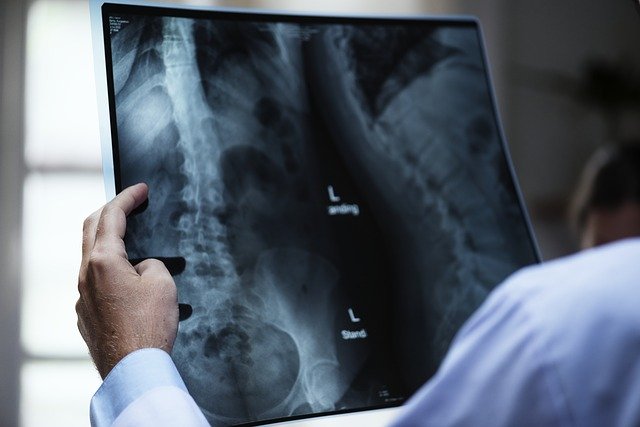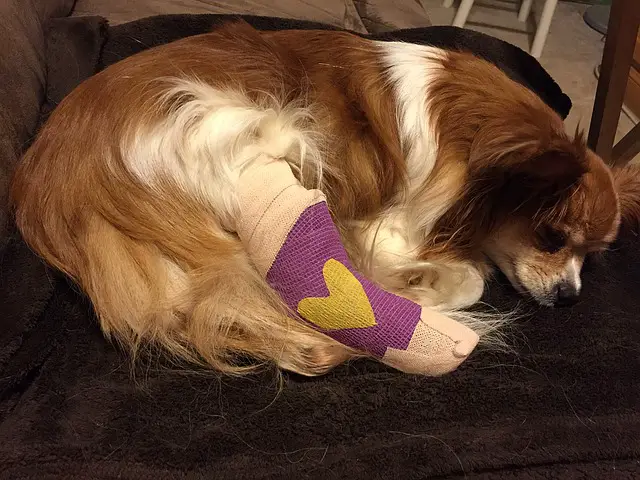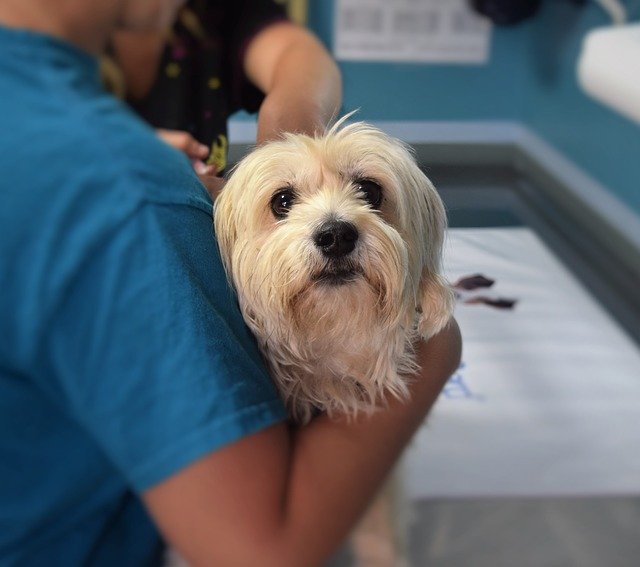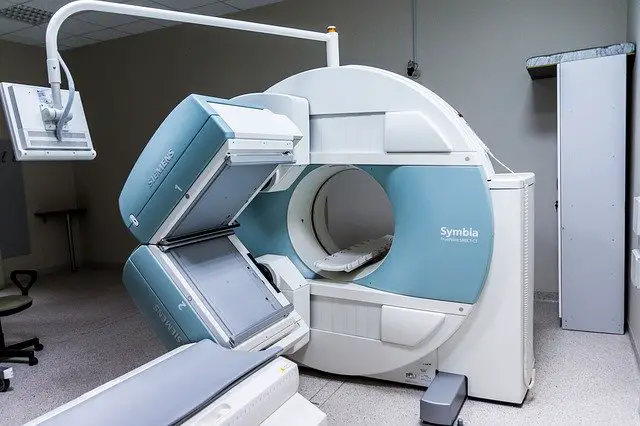
On average, a dog owner is going to spend between $1300 and $1800 on their pet. If he ever needs an x-ray within that period, then you can expect that these figures are going to increase significantly. Since you’re wondering “how much does a dog x-ray cost?” we guess your dog needs one for whatever reason, and that definitely sucks.
To prepare for your dog’s x-ray, though, there’s a lot to find out besides how much the x-ray would cost. You’re going to have to help your dog prepare for x-ray day both physically and mentally, and this guide contains everything you need to know.
An x-ray is a helpful diagnostic tool that helps your vet to see the internal structures of your dog’s body. This helps them with their diagnosis of certain conditions which they might be unable to pick up simply by looking at your dog. X-rays provide photos of internal structures such as your dog’s organs, bones, tissues, as well as foreign objects he might have swallowed, and bladder stones.
Table of Contents
How much Does A Dog X-Ray Cost?
Generally, a dog x-ray can cost anything between $75 and $500, depending on certain factors whether or not your dog would be sedated, the location of the injury to be x-rayed, and the number of views (single or multiple). Other factors like the location of the hospital where your dog would be x-rayed, the size of your dog, whether or not the x-ray would involve contrast, and whether or not it’s an emergency also affect how much your dog’s x-ray would cost.
However, before we look into those, here are a few reasons your dog might be requiring an x-ray.
This video shows an x-ray procedure and how it is carried out for dogs.
Reasons Your Dog Might Need An X-Ray
- A fractured bone.
- Orthopedic issues such as hip dysplasia.
- Swallowed object or foreign object in the body.
- Surgical follow-up.
- Stones.
- Cancer.
- Pregnancy.
- To examine organs in the body for damage.
- To find out if cancer is spreading to vital organs in the chest like the lungs.
- For breeding purposes
- To check for lesions in the paws in the case of valley fever.
Let’s explore each of these a little more closely:
1. Fractured Bone

If your pup has a fractured bone, or your vet suspects that he has one, they will most likely order an x-ray. An x-ray will allow your vet inspect your dog’s bones visually, for damage and, thereby, recommend the next course of action.
2. Other Various Orthopedic Issues
To diagnose hip dysplasia as well as similar orthopedic issues in dogs, an x-ray is often necessary. For example, with hip dysplasia, an x-ray is needed so that your vet can see the femur and hip socket in order to analyze how they fit with each other.
3. Swallowed Objects And/Or Foreign Body
If there’s an inedible item in your dog’s body, it can cause problems for your dog. This is another reason an x-ray has to be conducted to determine the location of the object.
When the location of the foreign object has been discovered, your vet will then attempt to remove the object and recommend further treatment procedures.
Foreign bodies can also enter into your dog’s body via penetration. X-rays also help to locate such objects as well.
4. Surgical Follow-Up
After a surgical procedure, your vet might need to run an x-ray in order to ensure that your dog is healing up nicely. So, if your dog suffered a broken leg and repair involved plates, pins, and screws, your vet will have to conduct an x-ray afterward to inspect the leg and make sure that everything is properly lining up.
5. Stones
Stones can occur anywhere from the kidney to the gallbladder, to the bladder. Such calcified stones are identified using x-rays. Once the presence of these stones have been verified and their location confirmed, your vet will be able to take them out intelligently, rather than having to do a blind hunt.
Sometimes, though, a procedure isn’t required and the stones are left to pass out on their own, which they often do without event.
6. Cancer
Certain kinds of tumors need to be identified via x-rays. Emphasis on “certain kinds.” not all tumors will show up well on an x-ray as some have an uncanny knack for blending in with surrounding tissues, making them difficult to spot. Still, an x-ray remains one of the best ways a cancer is identified in dogs.
7. Pregnancy
[amalinkspro type=”showcase” asin=”B000084DXS” apilink=”https://www.amazon.com/dp/B000084DXS?tag=dpg-amalinks03-20&linkCode=osi&th=1&psc=1″ new-window=”true” addtocart=”true” nofollow=”true” sc-id=”4″ imgs=”LargeImage” link-imgs=”false” specs=”High-quality protein to help your puppy build and maintain lean muscle~~~Made with purposeful, easily digestible ingredients your young dog will love~~~Pup-friendly formula with a powerful antioxidant blend for lifelong health~~~Promotes strong bones and strong teeth with balanced minerals~~~Made with natural ingredients~~~Made in the USA with global ingredients you can trust~~~#1 Veterinarian recommended. Recommended for-Puppies up to 1 year old and pregnant or nursing dogs. Not recommended for-Adult dogs, Adult 7+ dogs, obese or obese-prone dogs~~~” btn-color=”#ff9900″ btn-text=”View on Amazon” alignment=”aligncenter” hide-prime=”0″ hide-image=”0″ hide-reviews=”0″ hide-price=”1″ hide-button=”0″ width=”750″]Hill’s Science Diet Wet Dog Food, Puppy, Chicken & Barley Recipe, 13 oz Cans, 12-pack[/amalinkspro]
In the early stages of pregnancy, your vet will confirm pregnancy and check on developing puppies using ultrasound. However, as the pregnancy progresses, and the 45th day is reached, x-rays are typically used. This is because, at this time, puppies are mature enough to be seen on x-ray being that their skeletons have solidified enough.
It is with an x-ray that your vet can finally determine how many puppies you should be expecting from your pooch.
This video shows an x-ray imaging procedure for a pregnant dog.
Other reasons an x-ray is often recommended include
- To check out the shapes of certain organs in order to ascertain if there’s a problem.
- Chest x-rays are often ordered to find out if cancer is spreading to vital organs like the lungs.
- Many breeders have their dogs x-rayed in order to get certification from the OFA that their dogs are breeding specimens.
- In a case of valley fever, an x-ray is necessary to show whether or not the disease has led to the development of lesions in the bones of your dog’s paws.
Are X-Rays Always Effective For Dogs?
Though x-rays are very effective, they are not always a great option. Here are some examples of when x-rays do not work.
1. There are certain tumors that might not be visible with an x-ray as they tend to blend in with other tissues.
2. Some plastic objects when swallowed get stuck in the stomach and might not be visible with an x-ray.
3. Some parts of a dog’s body are not very clearly visible with an x-ray. For example, according to the VCA Animal Hospital, organs like the brain, the bladder, the lungs, some abdominal organs, several joints, as well as the inner structure of the heart do not turn up well in an x-ray.
For such organs, an ultrasound, a computed tomography (CT), or magnetic resonance imaging (MRI) are better options.
4. In the case of emergency, treatment takes priority over an x-ray.
What Are The Factors Influencing The Cost Of A Dog X-Ray?
There are a number of factors that could affect how much you end up spending on your doggie’s x-ray. The major ones are:
- Sedation.
- Location of injury.
- Number of views required (single or multiple).
- Location of the hospital.
- The size of the dog.
- Contrast (if contrast is needed, it increases cost).
- Appointment or Emergency (emergencies cost more).

1. Sedation
One question many dog owners often have about x-ray for their dogs is whether or not their dog would need sedation. Well, the answer will depend on your dog.
For most pets, neither sedation nor anesthesia is necessary for an abdominal x-ray as they usually stay still enough for the process to be carried out properly. The technician will just put your dog either on his back or on his side while the x-rays are taken.
If your dog, on the other hand, is fractious, or can’t stay still because he’s in so much pain, or maybe the x-ray requires that your dog holds an uncomfortable position to get a good image, your dog might have to be sedated or administered light anesthesia.
If, for instance, the case is a torn cruciate ligament, for instance, your vet might have to sedate your dog so that he can stay still for the x-rays as well as the drawer test. This way, the muscles are relaxed, so diagnosis is much easier.
X-rays involving the oral cavity, the spine, as well as the skull are also quite tricky, so sedation is often required.
Suffice it to say that if your dog indeed requires sedation, the cost of your x-ray goes up significantly.
2. Location Of The Injury
There are parts of the body that are easier to x-ray than others. The lower leg or the paw, for instance, are quite easy to x-ray. In contrast, the tail, and skull are much tougher to x-ray. Plus, they often require sedation to carry out. This also affects the cost of an x-ray.
3. Number Of Views Required (Single Vs Multiple X-Rays)
In some cases, your vet might need to see the object or the body part from different angles in order to make a definite diagnosis. In some other cases, your dog might have suffered a number of broken bones in different locations across the body.
In these cases, more than one x-ray would have to be taken. The average cost of the x-ray we mentioned initially refers to the cost of taking one x-ray. So, if more than one x-ray is required, you know what that means. The cost of that one x-ray multiplied by how many x-rays are required.
4. Location Of The Hospital
Like most services, the location of the vet clinic where your dog is getting his x-ray is also going to impact on the cost. If you live in an area where the median income is high, then you will definitely end up paying more than those who live in places where the citizens make a little less money.
In such a case, you might have to move to a lower-income vicinity to get a more affordable service.
5. The Size Of The Dog

How small or large your dog is will affect how much you spend on your dog. Larger dogs have larger bones and, therefore, their x-rays naturally cost more. For smaller dogs, bones are smaller, therefore, their x-rays cost much less.
6. Contrast
To make some parts of the body show up more effectively on x-ray, vets usually use some materials to make it more visible. For instance, with intestinal x-rays, images show up better when the dog takes barium milkshake before the procedure is carried out. These contrast-improving agents will raise the cost of the x-ray but only slightly.
7. Appointments Vs Emergency
Appointments are typically less expensive than emergency x-rays as to typically have them with your regular vet. Emergencies, on the other hand, are more expensive. However, if your dog has an emergency, please forget the cost and take your dog your dog in for an x-ray. If your vet clinic is not open 24 hours a day, try an animal hospital. There are some cases that only require a couple of hours to deteriorate from bad to worse.
How Can You Reduce The Cost Of Your Dog’s X-Rays?
If you’re on a budget, then there are some ways you can reduce the cost of your dog’s x-ray:
- Subscribe to a pet health insurance plan.
- Look out for teaching hospitals.
- Ask your vet for a discount.
- Find out what exactly you’re paying for and remove extra, unnecessary fees.
1. Pet Health Insurance
There are various pet health insurance plans a pet owner can subscribe to. There are conventional health insurance plans as well as bulk-buying discount plans.
For procedures such as x-rays, some insurance plans might help to cover a huge part of the costs. However, many of these plans demand a waiting period before they can become active. So, you’d need to obtain the needed policy in advance before needing one.
2. Look Out For Teaching Hospitals
There are many colleges with great veterinary programs that also run teaching clinics or hospitals. In these clinics or hospitals, students practice what they have learned in veterinary school with supervision from their superiors.
In most cases, these clinics cost less than other veterinary practices. You can consider using these clinics.
As for emergency vet clinics, they are convenient in that they are always open. Plus, you don’t need to set up an appointment before you can get attended to. However, this convenience is not without a cost. Oftentimes, you pay a lot more for services at emergency vet hospitals.
3. Speak To Your Vet And Ask For A Discount

If there’s no other way to reduce the cost of your dog’s x-ray, you can speak to your vet and ask them for a discount. Some vets are understanding and will do what they can to help. Some might give you a discount, others might allow you pay the bill over time.
4. Ask What You Are Paying For
Another thing you could do to beat the price of your dog’s x-ray is to find out what you are paying for. Ask the clinic to give you an itemized list of what exactly your expenses are. Sometimes, it could be that the clinic is including certain extras that you dog doesn’t exactly need.
If that’s the case, then you can talk to your vet to remove some of the extra fees.
Are X-Rays Safe For Your Dog?
The short answer to this is that x-rays are generally safe for dogs. The procedure itself only lasts a short time which is not enough for the radiation to cause significant damage. In large quantities though, x-rays can cause severe damage. This is why it is important that x–rays are only conducted when they are absolutely necessary. When it comes to ascertaining litter size, many experts disagree on the use of x-rays.
Nonetheless, no other procedure is as accurate as x-rays for determining expected number of puppies during pregnancy. For this reason, many dog breeders opt for x-rays and there hasn’t been any report of significant health concerns as a result.
Usually, vets x-ray dogs when they get to a certain stage of pregnancy to see how many puppies they are expecting. It’s believed that at that stage of pregnancy (about 45 days), puppies have developed their skeletons enough to be seen clearly on an x-ray.
But if pregnant human women are not usually exposed to x-rays to check on the unborn child, why is it okay to expose pregnant dogs to x-rays? Are x-rays actually necessary?
Well, you’d notice that you won’t be allowed to be with your dog while his x-ray is being taken. The technicians will also be wearing protective shields while conducting the x-rays. It’s because x-rays are quite harmful.
The Dogs Naturally Magazine says that x-rays account for about 18% of a dog’s exposure to radiation. Other exposures come from food, water, the air, and the ground. Over time, a build-up of this exposure will affect your dog negatively by causing changes to his chromosomes. Young animals, especially, are susceptible to the harmful effects of radiation.
For these reasons, therefore, the use of x-rays in animals is quite controversial. For most breeders, x-rays are helpful as they help them know all the puppies they should expect during whelping.
On the other hand, some people are of the opinion that pregnancy is not an illness and as such does not require an x-ray for diagnosis.
In truth, there are other ways besides an x-ray to know how many puppies to expect during whelping. However, none is as accurate as an x-ray. Your vet can palpate the abdomen of your dog at about 28 days (please do not try this at home).
Also, your vet can conduct an ultrasound at 21 days which gives a rough idea of litter size, although it is more expensive and still does not give an accurate number like an x-ray.
But here is a consoling fact. An x-ray only involves a short period of exposure to the radiation. While in large quantities this radiation can be damaging, the short expsoure your dog has to the rays in an x-ray procedure is not enough to cause long-lasting effects.
Nonetheless, x-rays should only be performed when absolutely necessary.
Should Your Dog Fast Before His X-Ray?
If the x-ray would demand sedation, then have your pet observe a 12-hour fast before the x-ray. But make sure he stays hydrated by feeding him water consistently till 6 am on the scheduled day of the x-ray. If your dog won’t be sedated, then a fast might not be necessary but still recommended to prevent unnecessary complications during the procedure. For x-rays on the digestive tract, ask your vet whether or not your dog should fast before the x-ray.
What Are Other Ways You Can Prepare Your Dog For His X-Ray?
Other things to do to help prepare for your dog x-ray are to help your dog relax. You want to stick to your regular routine so your dog is calm. Also, keep from arriving too early at the vet’s office. Instead try arriving just on time. It’s also to keep your pet calm and relaxed.
Don’t forget to consider pet insurance. It can save you from unexpected costs in the future.
Check out these other helpful articles:
- Organic dog food — what it really is (it’s not what you think!).
- Hypoallergenic dog foods — feeding dogs with allergies.
- Low-residue dog food — the what, why, when, and how.
- Low fat dog food — managing canine obesity and pancreatitis.
- Dog footwear — paws are feet, not footwear.
- Dog training collar: all you need to know.
What Are Other Medical Imaging Options For Dogs Besides X-Rays?
Typically, an x-ray is the first thing that comes to mind when you think of medical imaging. However, there are other types of medical imaging. They are usually highly-specified and give your vet the benefit of hyper-focus on certain parts of the body that need to be viewed.
- Ultrasound.
- CT scan.
- MRI.
Ultrasound

Ultrasound is used to detect diseases around the abdomen including diseases that an x-ray might not be able to pick up on. Like with humans, an ultrasound is conducted by projecting high-frequency sound waves into your dog’s body. These waves are harmless so it’s nothing to be scared of.
These sound beams are so quiet that even though your dog’s ears are infinitely better than yours, they still can’t pick up on these ultrasound emissions.
CT Scan
This is another medical imaging technique that a vet can sometimes resort to. It’s also carried out on humans, as you know, and can also be called a cat scan.
Technically referred to as computed tomography, a CT scan takes a series of x-ray images in rapid succession. The result of the scan is, therefore, a somewhat “sliced” cross-section of the body part in focus.
A CT scan is typically the medical imaging technique of choice when the more complex parts of the body need to be viewed. Examples of such body parts include the head, chest, and certain joints as well.
MRI

Another type of medical imaging that can also be carried out on your dog is an MRI. In this method, magnetic field and radio waves are used rather than x-rays to generate the images.
This imaging technique can pick up on certain changes in tissues of the body and can be useful in helping your vet determine if your dog has a brain or spinal cord condition.
How Much Do These Techniques Cost?
Well, how much theses other techniques beyond x-rays cost is based on which technique is actually used.
Ultrasounds are not usually so expensive, and can sometimes, cost as much as an x-ray. Ultrasounds cost between $300 and $500 in most cases. How much you actually end up spending, though, would depend on who does the procedure.
If your vet refers you to a specialty clinic, the cost will definitely go up considerably. Ultrasound requires special equipment that your vet might not have the training to handle. In such a case, they might have to refer you to a specialty clinic and that could increase cost.
Ultrasounds are the cheapest special imaging technique you’d probably get to do. A CT scan or an MRI is much more expensive costing as much as $2500 per scan. And, in most cases, these scans are never done once. So, you might have to pay for multiple scans which is quite expensive as we have seen.
Ther reason CT scans and MRIs are this expensive is that the machines used to perform the imaging are quite rare and only found in the most advanced diagnostic centers typically found in vet schools or larger cities.
For such scans, you can’t just make an appointment, you’d have to get a referral from your vet first.
How Much Does A Dog X-Ray Cost? — Related FAQs
Do Dogs Need To Be Sedated For X-Rays?
Mostly, this depends on whether or not your dog is squirmish or in pain. If he’s put together for the most part, he might not need one but if he shows signs of discomfort or distress, the technician might have to sedate him. Besides that, the type of x-ray being conducted will also determine whether or not sedation is required. For the most part though, it boils down to how your pet is feeling about the procedure.
Are Dog X-Rays Expensive?
Dog x-rays can go from fairly pricey to quite expensive, costing between $75 and $500 on average. Factors that make dog x-rays more expensive include the location of the x-ray, the use of sedation, if multiple images are required, and if your vet clinic is located in an area with a high cost of living.
Is Sedating A Dog Safe?
With the use of better protocols, safer drugs, and more sophisticated monitoring, veterinary anesthesia has become very safe for pets, generally. 99.85% of sedated pets survive anesthesia which is a huge success rate.
For pets that don’t survive anesthesia, death usually occurs after sedation and not during. It is, therefore, important to have the conversation with your vet about the recovery process for your dog after sedation as this could be the thin line between life and death.
How Much Does It Cost To Sedate A Dog At The Vet?
The cost of sedation or anesthesia for dogs varies depending on the size of the dog. For a large dog, sedation can cost anywhere between $50 and $220. For smaller dogs, on the other hand, prices could range from $40 to $180 on average. This, of course, does not take the cost for the office visit which could go for between $50 and $100.
Why Do Dogs Cry After Anesthesia?
One of the side effects of administering anesthesia is a brief spell of dysphoria. As the anesthesia begins to wear off gradually, your dog will start to feel confused and disoriented and this would naturally cause him to whine. You can expect this to last for about 12 to 14 hours as the anesthesia wears off. It can be a little frustrating but you’d have to do your best to reassure your pet and make him feel as relaxed as possible while he regains his bearing.
When Can A Pregnant Dog Have An X-Ray?
The skeleton of puppies in the womb won’t show up on x-ray until day 45 of pregnancy. Hence, an x-ray to confirm the number of puppies in a pregnant dog’s womb would only be possible after day 45 of pregnancy.
Your vet can recommend an x-ray after whelping if you need to confirm that all the puppies have been born. If you want to confirm pregnancy earlier, you can use ultrasound from day 28 after mating. Ultrasound, however, won’t tell you how many puppies to expect, only x-rays can.
